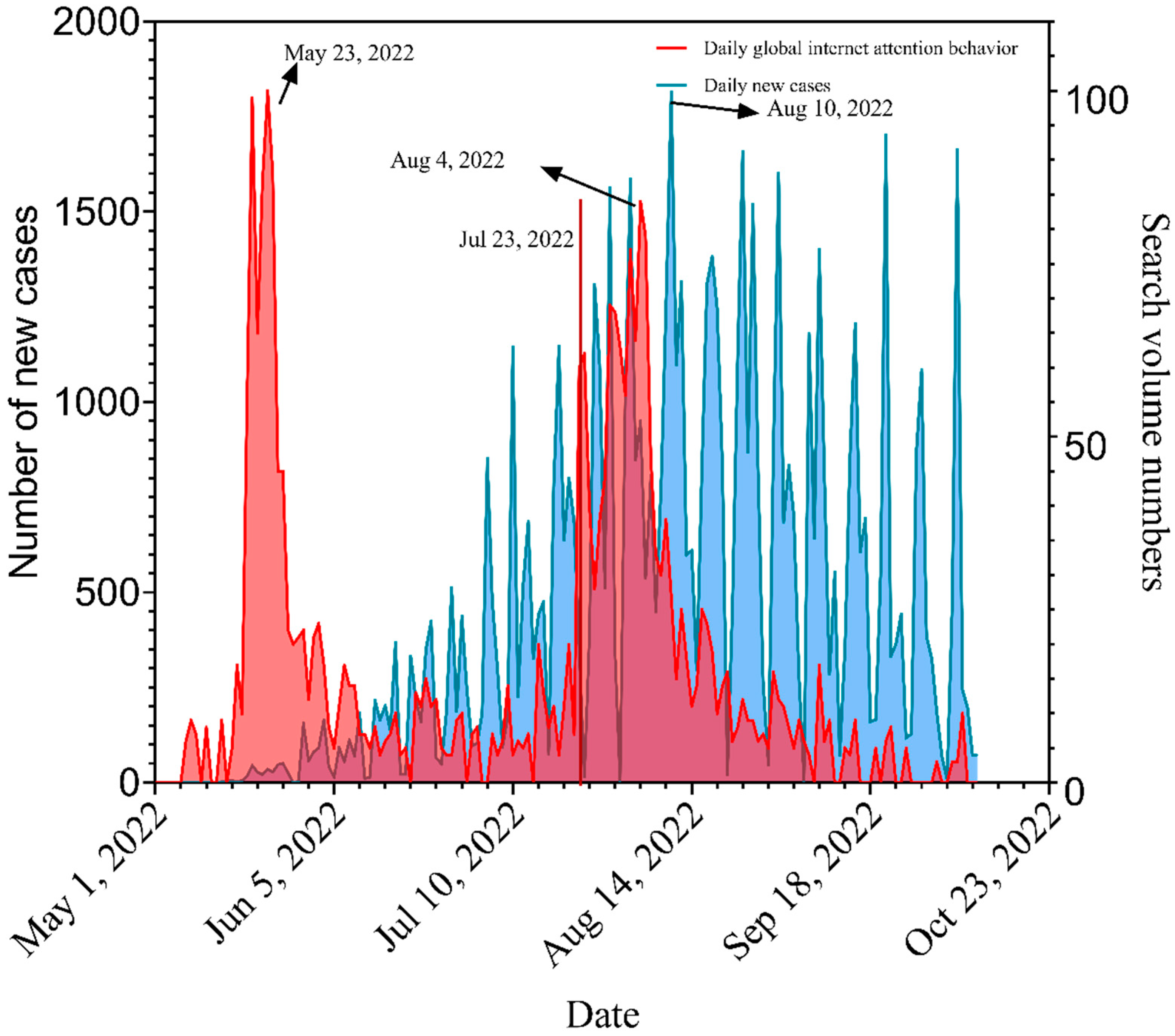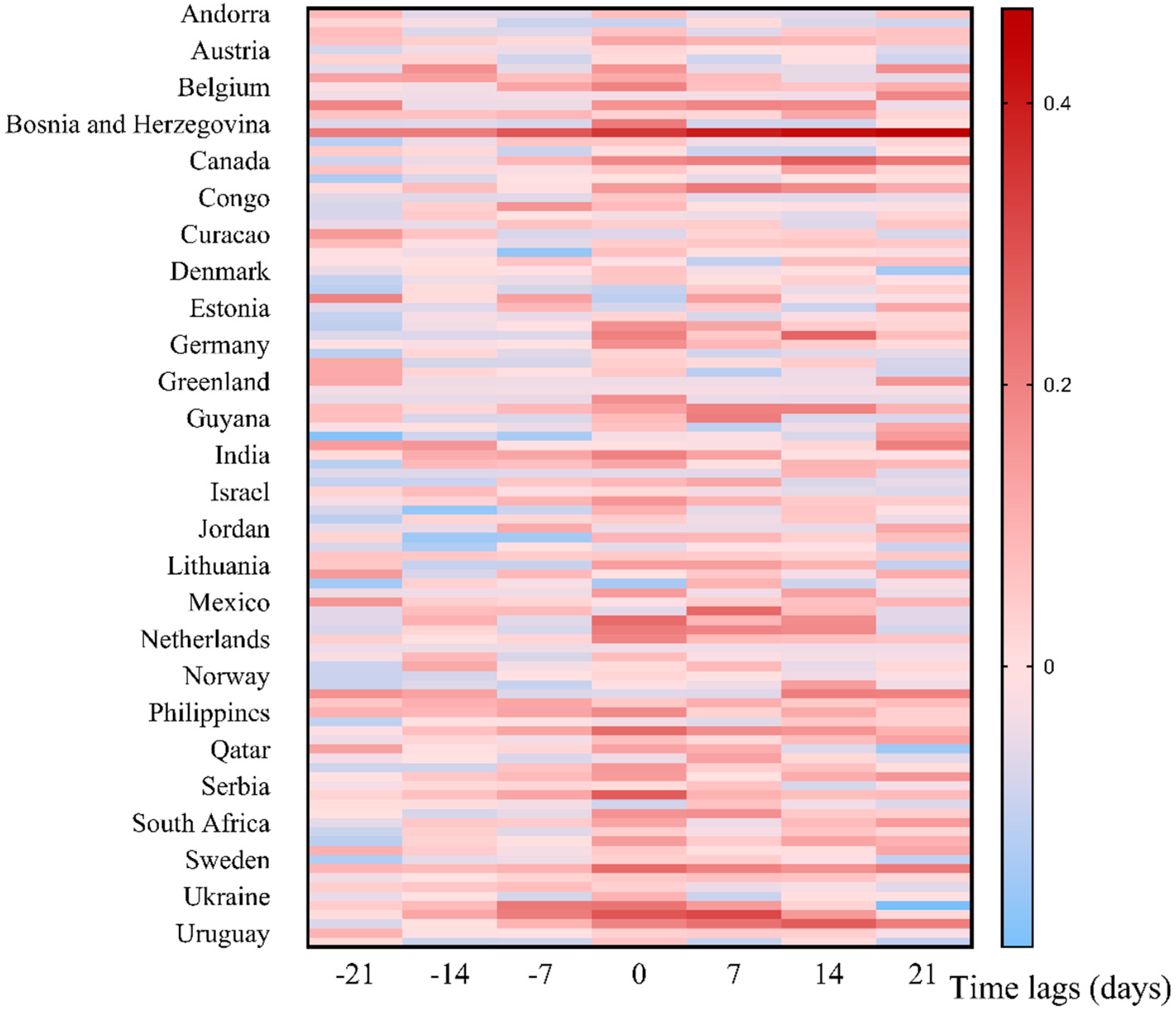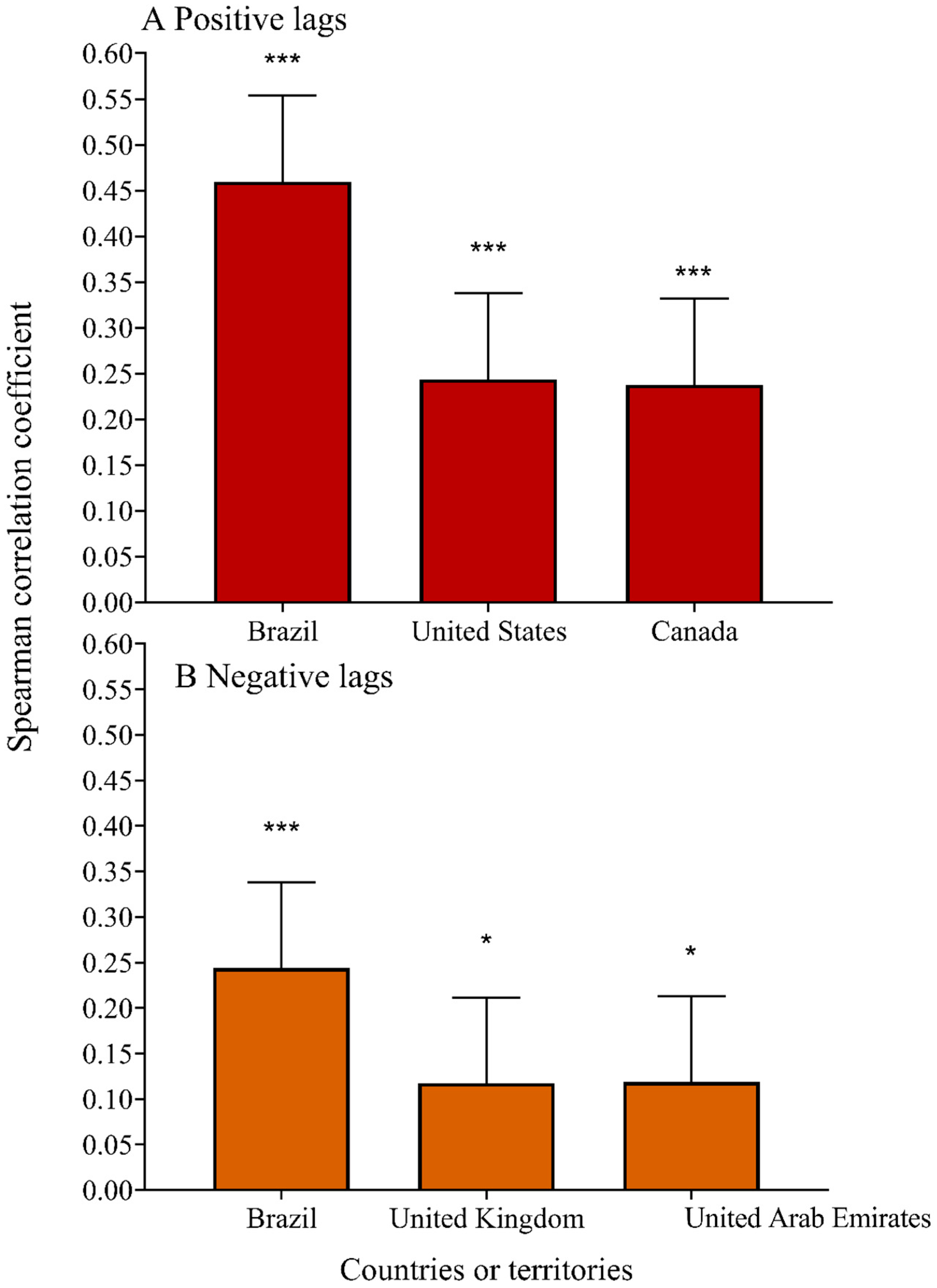Trends in Online Search Activity and the Correlation with Daily New Cases of Monkeypox among 102 Countries or Territories
Abstract
1. Introduction
2. Materials and Methods
2.1. Daily New Cases of Mpox and Online Search Activity
2.2. Covariates
2.3. Statistical Analysis
3. Results
3.1. The Trend in Global Online Search Activity
3.2. Time-Lag Correlations of Online Search Activity and New Cases of Mpox
4. Discussion
5. Conclusions
Supplementary Materials
Author Contributions
Funding
Institutional Review Board Statement
Informed Consent Statement
Data Availability Statement
Conflicts of Interest
References
- Mukinda, V.B.; Mwema, G.; Kilundu, M.; Heymann, D.L.; Khan, A.S.; Esposito, J.J. Re-emergence of human monkeypox in Zaire in 1996. Monkeypox Epidemiologic Working Group. Lancet 1997, 349, 1449–1450. [Google Scholar] [CrossRef]
- Rezza, G. Emergence of human monkeypox in west Africa. Lancet Infect. Dis. 2019, 19, 797–799. [Google Scholar] [CrossRef]
- African, C.D.C. Monkeypox. 2022. Available online: https://africacdc.org/disease/monkeypox/ (accessed on 1 February 2023).
- Walter, K.; Malani, P.N. What Is Monkeypox? JAMA 2022, 328, 222. [Google Scholar] [CrossRef] [PubMed]
- Multi-Country Monkeypox Outbreak: Situation. 2022. Available online: https://www.who.int/emergencies/emergency-events/item/2022-e000121 (accessed on 1 February 2023).
- Monkeypox and Orthopoxvirus Outbreak Global Map. 2022. Available online: https://www.cdc.gov/poxvirus/monkeypox/response/2022/world-map.html (accessed on 1 February 2023).
- Du, M.; Sun, H.; Zhang, S.; Yuan, J.; Yan, W.; Liu, Q.; Qin, C.; Liu, M.; Liu, J. Global Epidemiological Features of Human Monkeypox Cases and Their Associations with Social-Economic Level and International Travel Arrivals: A Systematic Review and Ecological Study. Int. J. Public Health 2023, 68, 1605426. [Google Scholar] [CrossRef] [PubMed]
- Du, M.; Liu, M.; Liu, J. Epidemiological, clinical characteristics, prevention, and control of monkeypox. Zhonghua Liu Xing Bing Xue Za Zhi 2022, 43, 2030–2035. [Google Scholar] [PubMed]
- Second Meeting of the International Health Regulations (IHR). Emergency Committee Regarding the Multi-Country Outbreak of Monkeypox. 2005. Available online: https://www.who.int/director-general/speeches/detail/who-director-general-s-statement-on-the-press-conference-following-IHR-emergency-committee-regarding-the-multi--country-outbreak-of-monkeypox--23-july-2022 (accessed on 1 February 2023).
- Thakur, N. MonkeyPox2022Tweets: A Large-Scale Twitter Dataset on the 2022 Monkeypox Outbreak, Findings from Analysis of Tweets, and Open Research Questions. Infect. Dis. Rep. 2022, 14, 855–883. [Google Scholar] [CrossRef] [PubMed]
- Sv, P.; Ittamalla, R. What concerns the general public the most about monkeypox virus?—A text analytics study based on Natural Language Processing (NLP). Travel Med. Infect. Dis. 2022, 49, 102404. [Google Scholar] [CrossRef]
- Davido, B.; D’anglejan, E.; Jourdan, J.; Robinault, A.; Davido, G. Monkeypox 2022 outbreak: Cases with exclusive genital lesions. J. Travel Med. 2022, 29, taac077. [Google Scholar] [CrossRef] [PubMed]
- Lippi, G.; Mattiuzzi, C.; Cervellin, G. Is Digital Epidemiology the Future of Clinical Epidemiology? J. Epidemiol. Glob. Health 2019, 9, 146. [Google Scholar] [CrossRef]
- Abbas, M.; Morland, T.B.; Hall, E.S.; El-Manzalawy, Y. Associations between Google Search Trends for Symptoms and COVID-19 Confirmed and Death Cases in the United States. Int. J. Environ. Res. Public Health 2021, 18, 4560. [Google Scholar] [CrossRef]
- Boehm, A.; Pizzini, A.; Sonnweber, T.; Loeffler-Ragg, J.; Lamina, C.; Weiss, G.; Tancevski, I. Assessing global COPD awareness with Google Trends. Eur. Respir. J. 2019, 53, 1900351. [Google Scholar] [CrossRef] [PubMed]
- Yuan, K.; Huang, G.; Wang, L.; Wang, T.; Liu, W.; Jiang, H.; Yang, A.C. Predicting Norovirus in the United States Using Google Trends: Infodemiology Study. J. Med. Internet Res. 2021, 23, e24554. [Google Scholar] [CrossRef] [PubMed]
- Cervellin, G.; Comelli, I.; Lippi, G. Is Google Trends a reliable tool for digital epidemiology? Insights from different clinical settings. J. Epidemiol. Glob. Health 2017, 7, 185–189. [Google Scholar] [CrossRef] [PubMed]
- Adawi, M.; Bragazzi, N.L.; Watad, A.; Sharif, K.; Amital, H.; Mahroum, N. Discrepancies Between Classic and Digital Epidemiology in Searching for the Mayaro Virus: Preliminary Qualitative and Quantitative Analysis of Google Trends. JMIR Public Health Surveill. 2017, 3, e93. [Google Scholar] [CrossRef] [PubMed]
- Liu, Y.; Yue, Z.; Anwar, M. Monkeypox At-a-glance from Google Trends and Reddit. In Proceedings of the 2022 IEEE/ACM Conference on Connected Health: Applications, Systems and Engineering Technologies (CHASE), Arlington, VA, USA, 17–19 November 2022; pp. 166–167. [Google Scholar]
- Martins-Filho, P.R.; de Souza Araújo, A.A.; Quintans-Júnior, L.J. Global online public interest in monkeypox compared with COVID-19: Google trends in 2022. J. Travel Med. 2022, 29, taac104. [Google Scholar] [CrossRef]
- Arora, V.S.; McKee, M.; Stuckler, D. Google Trends: Opportunities and limitations in health and health policy research. Health Policy 2019, 123, 338–341. [Google Scholar] [CrossRef] [PubMed]
- Global Burden of Disease Collaborative Network. Global Burden of Disease Collaborative Network. Global Burden of Disease Study 2019 (GBD 2019) Human Resources for Health 1990–2019; Institute for Health Metrics and Evaluation (IHME): Seattle, WA, USA, 2020; Available online: https://ghdx.healthdata.org/record/ihme-data/gbd-2019-human-resourceshealth-1990-2019 (accessed on 26 June 2022).
- Zhang, H.X.; Han, M.J.; Zhou, Y.; Xiu, X.F.; Xu, F.; Wang, L. Interrupted time series analysis for influence on HIV related fatality of implementation of ‘Four Free Services One Care’ policy in China. Zhonghua Liu Xing Bing Xue Za Zhi 2020, 41, 406–411. [Google Scholar] [CrossRef]
- Du, M.; Yang, J.; Han, N.; Liu, M.; Liu, J. Association between the COVID-19 pandemic and the risk for adverse pregnancy outcomes: A cohort study. BMJ Open 2021, 11, e047900. [Google Scholar] [CrossRef]
- Qin, C.; Liu, M.; Guo, X.; Liu, J. Human Resources in Primary Health-Care Institutions before and after the New Health-Care Reform in China from 2003 to 2019: An Interrupted Time Series Analysis. Int. J. Environ. Res. Public Health 2022, 19, 6042. [Google Scholar] [CrossRef]
- Li, Y.; Shi, B.; Li, S. Association between serum chemerin concentrations and clinical indices in obesity or metabolic syndrome: A meta-analysis. PLoS ONE 2014, 9, e113915. [Google Scholar] [CrossRef]
- Higgins, J.P.; Thompson, S.G. Controlling the risk of spurious findings from meta-regression. Stat. Med. 2004, 23, 1663–1682. [Google Scholar] [CrossRef] [PubMed]
- Higgins, J.P.; Thompson, S.G. Quantifying heterogeneity in a meta-analysis. Stat. Med. 2002, 21, 1539–1558. [Google Scholar] [CrossRef] [PubMed]
- Costa, F.F. Social networks, web-based tools and diseases: Implications for biomedical research. Drug Discov. Today 2013, 18, 272–281. [Google Scholar] [CrossRef] [PubMed]




| Negative Lags | Positive Lags | |||
|---|---|---|---|---|
| Countries or Territories | Spearman Correlation Coefficient | P-Value | Spearman Correlation Coefficient | P-Value |
| World | −0.099 (−0.193, −0.005) | 0.038 | 0.241 (0.147, 0.335) | <0.001 |
| Andorra | −0.012 (−0.106, 0.082) | 0.795 | −0.019 (−0.113, 0.075) | 0.692 |
| Argentina | −0.035 (−0.129, 0.059) | 0.469 | −0.046 (−0.140, 0.048) | 0.340 |
| Aruba | −0.021 (−0.115, 0.073) | 0.662 | 0.013 (−0.081, 0.107) | 0.787 |
| Australia | 0.037 (−0.057, 0.131) | 0.437 | 0.081 (−0.013, 0.175) | 0.092 |
| Austria | −0.051 (−0.145, 0.042) | 0.283 | −0.025 (−0.119, 0.069) | 0.600 |
| Bahamas | −0.011 (−0.105, 0.083) | 0.819 | −0.055 (−0.149, 0.039) | 0.248 |
| Bahrain | 0.020 (−0.126, 0.166) | 0.790 | 0.021 (−0.128, 0.169) | 0.785 |
| Barbados | 0.112 (0.018, 0.206) | 0.019 | −0.008 (−0.102, 0.086) | 0.863 |
| Belgium | 0.025 (−0.069, 0.119) | 0.598 | 0.077 (−0.017, 0.171) | 0.107 |
| Benin | −0.036 (−0.130, 0.058) | 0.451 | 0.039 (−0.107, 0.185) | 0.601 |
| Bermuda | 0.034 (−0.117, 0.185) | 0.662 | 0.113 (−0.038, 0.264) | 0.141 |
| Bolivia | 0.073 (−0.021, 0.167) | 0.127 | 0.056 (−0.038, 0.149) | 0.247 |
| Bosnia and Herzegovina | −0.069 (−0.163, 0.025) | 0.150 | −0.058 (−0.152, 0.036) | 0.226 |
| Brazil | 0.244 (0.150, 0.338) | <0.001 | 0.460 (0.366, 0.554) | <0.001 |
| Bulgaria | −0.032 (−0.126, 0.062) | 0.505 | −0.016 (−0.110, 0.078) | 0.742 |
| Cameroon | −0.013 (−0.107, 0.081) | 0.789 | −0.067 (−0.160, 0.027) | 0.165 |
| Canada | −0.013 (−0.107, 0.081) | 0.791 | 0.238 (0.144, 0.332) | <0.001 |
| Chile | 0.016 (−0.078, 0.110) | 0.732 | 0.046 (−0.048, 0.140) | 0.335 |
| China | −0.068 (−0.162, 0.026) | 0.155 | −0.017 (−0.111, 0.076) | 0.715 |
| Colombia | 0.031 (−0.063, 0.125) | 0.513 | 0.173 (0.079, 0.267) | <0.001 |
| Congo | −0.062 (−0.156, 0.032) | 0.196 | −0.056 (−0.150, 0.038) | 0.244 |
| Costa Rica | 0.042 (−0.094, 0.178) | 0.548 | −0.018 (−0.112, 0.076) | 0.707 |
| Croatia | −0.010 (−0.104, 0.084) | 0.836 | −0.026 (−0.120, 0.068) | 0.585 |
| Cuba | −0.008 (−0.102, 0.086) | 0.867 | 0.012 (−0.082, 0.106) | 0.798 |
| Curacao | 0.044 (−0.050, 0.138) | 0.361 | −0.002 (−0.096, 0.092) | 0.961 |
| Cyprus | 0.000 (−0.094, 0.094) | 0.994 | 0.054 (−0.040, 0.147) | 0.264 |
| Czechia | −0.076 (−0.170, 0.018) | 0.115 | −0.009 (−0.103, 0.085) | 0.847 |
| Democratic Republic of Congo | 0.013 (−0.081, 0.107) | 0.786 | 0.009 (−0.085, 0.102) | 0.859 |
| Denmark | −0.018 (−0.112, 0.076) | 0.701 | −0.057 (−0.151, 0.037) | 0.234 |
| Dominican Republic | −0.062 (−0.156, 0.032) | 0.196 | 0.007 (−0.087, 0.101) | 0.888 |
| Ecuador | −0.060 (−0.154, 0.034) | 0.209 | 0.012 (−0.082, 0.106) | 0.803 |
| El Salvador | 0.113 (0.019, 0.207) | 0.018 | 0.034 (−0.060, 0.128) | 0.477 |
| Estonia | −0.011 (−0.105, 0.083) | 0.821 | 0.023 (−0.071, 0.117) | 0.627 |
| Finland | −0.059 (−0.153, 0.035) | 0.215 | −0.028 (−0.122, 0.066) | 0.554 |
| France | −0.051 (−0.145, 0.043) | 0.284 | 0.066 (−0.028, 0.160) | 0.167 |
| Georgia | −0.066 (−0.160, 0.028) | 0.166 | 0.126 (0.032, 0.220) | 0.009 |
| Germany | −0.011 (−0.105, 0.083) | 0.814 | 0.048 (−0.046, 0.142) | 0.317 |
| Ghana | −0.051 (−0.145, 0.043) | 0.288 | −0.065 (−0.159, 0.029) | 0.174 |
| Gibraltar | −0.015 (−0.109, 0.079) | 0.753 | −0.006 (−0.100, 0.088) | 0.903 |
| Greece | 0.040 (−0.054, 0.134) | 0.401 | −0.083 (−0.176, 0.011) | 0.085 |
| Greenland | 0.010 (−0.084, 0.104) | 0.833 | 0.023 (−0.071, 0.117) | 0.633 |
| Guadeloupe | −0.034 (−0.128, 0.060) | 0.482 | −0.031 (−0.125, 0.063) | 0.520 |
| Guam | −0.052 (−0.146, 0.042) | 0.282 | −0.050 (−0.144, 0.044) | 0.300 |
| Guatemala | 0.061 (−0.033, 0.155) | 0.202 | 0.169 (0.075, 0.263) | <0.001 |
| Guyana | −0.026 (−0.120, 0.068) | 0.589 | 0.023 (−0.164, 0.210) | 0.807 |
| Honduras | −0.028 (−0.122, 0.066) | 0.556 | −0.012 (−0.106, 0.082) | 0.805 |
| Hungary | −0.137 (−0.230, −0.043) | 0.004 | 0.017 (−0.077, 0.111) | 0.725 |
| Iceland | 0.093 (−0.001, 0.187) | 0.052 | 0.067 (−0.068, 0.202) | 0.331 |
| India | 0.085 (−0.008, 0.179) | 0.075 | 0.037 (−0.057, 0.131) | 0.440 |
| Indonesia | 0.015 (−0.079, 0.109) | 0.754 | 0.059 (−0.035, 0.153) | 0.217 |
| Iran | −0.065 (−0.159, 0.029) | 0.177 | −0.014 (−0.108, 0.080) | 0.773 |
| Ireland | −0.043 (−0.137, 0.051) | 0.365 | 0.002 (−0.092, 0.096) | 0.967 |
| Israel | 0.029 (−0.065, 0.123) | 0.548 | −0.052 (−0.146, 0.042) | 0.277 |
| Italy | 0.033 (−0.061, 0.127) | 0.495 | 0.062 (−0.032, 0.156) | 0.194 |
| Jamaica | −0.113 (−0.207, −0.019) | 0.018 | −0.005 (−0.099, 0.089) | 0.924 |
| Japan | −0.020 (−0.114, 0.074) | 0.676 | −0.012 (−0.106, 0.082) | 0.798 |
| Jordan | 0.009 (−0.085, 0.103) | 0.856 | 0.005 (−0.089, 0.099) | 0.915 |
| Latvia | −0.094 (−0.188, 0.000) | 0.051 | 0.065 (−0.029, 0.159) | 0.176 |
| Lebanon | −0.064 (−0.158, 0.030) | 0.182 | −0.038 (−0.132, 0.056) | 0.433 |
| Liberia | 0.052 (−0.042, 0.146) | 0.275 | 0.041 (−0.053, 0.135) | 0.393 |
| Lithuania | −0.051 (−0.145, 0.043) | 0.288 | 0.045 (−0.101, 0.191) | 0.548 |
| Luxembourg | 0.052 (−0.042, 0.146) | 0.281 | 0.043 (−0.051, 0.137) | 0.371 |
| Malta | −0.045 (−0.139, 0.049) | 0.349 | −0.005 (−0.099, 0.089) | 0.911 |
| Martinique | −0.039 (−0.133, 0.055) | 0.419 | 0.017 (−0.077, 0.111) | 0.726 |
| Mexico | 0.071 (−0.023, 0.165) | 0.137 | 0.066 (−0.028, 0.160) | 0.171 |
| Moldova | 0.035 (−0.059, 0.129) | 0.470 | 0.092 (−0.087, 0.271) | 0.315 |
| Montenegro | −0.007 (−0.101, 0.087) | 0.887 | 0.069 (−0.068, 0.206) | 0.326 |
| Morocco | −0.039 (−0.133, 0.055) | 0.417 | 0.102 (−0.074, 0.278) | 0.257 |
| Netherlands | 0.021 (−0.073, 0.115) | 0.665 | 0.069 (−0.025, 0.163) | 0.150 |
| New Caledonia | −0.042 (−0.136, 0.052) | 0.377 | −0.040 (−0.134, 0.054) | 0.403 |
| New Zealand | −0.007 (−0.100, 0.087) | 0.892 | −0.027 (−0.121, 0.067) | 0.573 |
| Nigeria | −0.001 (−0.095, 0.093) | 0.981 | 0.018 (−0.076, 0.112) | 0.710 |
| Norway | −0.057 (−0.151, 0.037) | 0.238 | −0.021 (−0.115, 0.073) | 0.667 |
| Panama | −0.085 (−0.179, 0.009) | 0.075 | 0.021 (−0.073, 0.115) | 0.656 |
| Paraguay | 0.075 (−0.069, 0.218) | 0.307 | 0.114 (−0.065, 0.292) | 0.213 |
| Peru | 0.094 (0.000, 0.188) | 0.049 | 0.078 (−0.016, 0.172) | 0.105 |
| Philippines | 0.106 (0.012, 0.200) | 0.026 | 0.061 (−0.033, 0.155) | 0.204 |
| Poland | −0.036 (−0.130, 0.058) | 0.448 | 0.008 (−0.086, 0.102) | 0.867 |
| Portugal | 0.061 (−0.033, 0.155) | 0.200 | 0.147 (0.053, 0.241) | 0.002 |
| Puerto Rico | −0.018 (−0.112, 0.076) | 0.711 | 0.072 (−0.022, 0.166) | 0.134 |
| Qatar | 0.046 (−0.048, 0.140) | 0.341 | −0.036 (−0.185, 0.113) | 0.636 |
| Romania | −0.037 (−0.131, 0.057) | 0.437 | 0.033 (−0.061, 0.127) | 0.494 |
| Russia | −0.033 (−0.127, 0.060) | 0.485 | 0.037 (−0.057, 0.131) | 0.436 |
| Saudi Arabia | 0.042 (−0.052, 0.136) | 0.376 | 0.087 (−0.007, 0.181) | 0.069 |
| Serbia | 0.004 (−0.090, 0.098) | 0.934 | −0.014 (−0.108, 0.080) | 0.772 |
| Singapore | 0.076 (−0.018, 0.170) | 0.112 | 0.085 (−0.009, 0.179) | 0.077 |
| Slovakia | −0.006 (−0.100, 0.088) | 0.903 | −0.011 (−0.104, 0.083) | 0.826 |
| Slovenia | −0.046 (−0.140, 0.048) | 0.339 | 0.089 (−0.005, 0.183) | 0.063 |
| South Africa | 0.016 (−0.078, 0.110) | 0.738 | 0.058 (−0.035, 0.152) | 0.223 |
| South Korea | −0.038 (−0.132, 0.056) | 0.433 | 0.017 (−0.077, 0.111) | 0.726 |
| Spain | −0.031 (−0.125, 0.063) | 0.514 | 0.090 (−0.004, 0.184) | 0.060 |
| Sudan | 0.037 (−0.057, 0.131) | 0.443 | 0.037 (−0.057, 0.131) | 0.441 |
| Sweden | −0.073 (−0.167, 0.021) | 0.129 | −0.026 (−0.120, 0.068) | 0.585 |
| Switzerland | 0.089 (−0.005, 0.183) | 0.065 | 0.194 (0.100, 0.288) | <0.001 |
| Thailand | −0.004 (−0.098, 0.090) | 0.936 | 0.051 (−0.043, 0.145) | 0.284 |
| Turkey | 0.055 (−0.039, 0.149) | 0.254 | −0.045 (−0.139, 0.049) | 0.352 |
| Ukraine | −0.044 (−0.138, 0.050) | 0.361 | −0.034 (−0.128, 0.060) | 0.476 |
| United Arab Emirates | 0.119 (0.025, 0.213) | 0.013 | −0.009 (−0.208, 0.190) | 0.931 |
| United Kingdom | 0.117 (0.024, 0.211) | 0.014 | 0.165 (−0.010, 0.340) | 0.064 |
| United States | 0.011 (−0.083, 0.105) | 0.811 | 0.244 (0.150, 0.337) | <0.001 |
| Uruguay | 0.028 (−0.066, 0.121) | 0.566 | 0.020 (−0.074, 0.114) | 0.682 |
| Venezuela | −0.056 (−0.150, 0.038) | 0.245 | −0.063 (−0.157, 0.031) | 0.190 |
Disclaimer/Publisher’s Note: The statements, opinions and data contained in all publications are solely those of the individual author(s) and contributor(s) and not of MDPI and/or the editor(s). MDPI and/or the editor(s) disclaim responsibility for any injury to people or property resulting from any ideas, methods, instructions or products referred to in the content. |
© 2023 by the authors. Licensee MDPI, Basel, Switzerland. This article is an open access article distributed under the terms and conditions of the Creative Commons Attribution (CC BY) license (https://creativecommons.org/licenses/by/4.0/).
Share and Cite
Du, M.; Qin, C.; Yan, W.; Liu, Q.; Wang, Y.; Zhu, L.; Liang, W.; Liu, M.; Liu, J. Trends in Online Search Activity and the Correlation with Daily New Cases of Monkeypox among 102 Countries or Territories. Int. J. Environ. Res. Public Health 2023, 20, 3395. https://doi.org/10.3390/ijerph20043395
Du M, Qin C, Yan W, Liu Q, Wang Y, Zhu L, Liang W, Liu M, Liu J. Trends in Online Search Activity and the Correlation with Daily New Cases of Monkeypox among 102 Countries or Territories. International Journal of Environmental Research and Public Health. 2023; 20(4):3395. https://doi.org/10.3390/ijerph20043395
Chicago/Turabian StyleDu, Min, Chenyuan Qin, Wenxin Yan, Qiao Liu, Yaping Wang, Lin Zhu, Wannian Liang, Min Liu, and Jue Liu. 2023. "Trends in Online Search Activity and the Correlation with Daily New Cases of Monkeypox among 102 Countries or Territories" International Journal of Environmental Research and Public Health 20, no. 4: 3395. https://doi.org/10.3390/ijerph20043395
APA StyleDu, M., Qin, C., Yan, W., Liu, Q., Wang, Y., Zhu, L., Liang, W., Liu, M., & Liu, J. (2023). Trends in Online Search Activity and the Correlation with Daily New Cases of Monkeypox among 102 Countries or Territories. International Journal of Environmental Research and Public Health, 20(4), 3395. https://doi.org/10.3390/ijerph20043395








